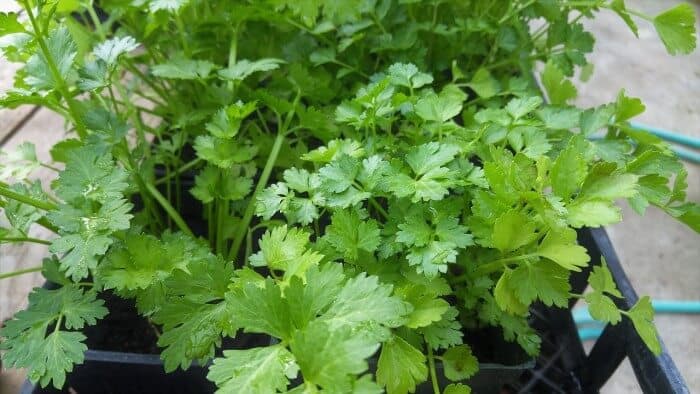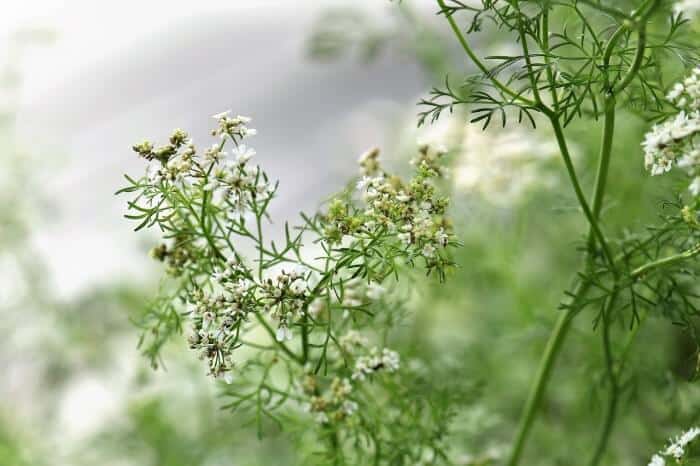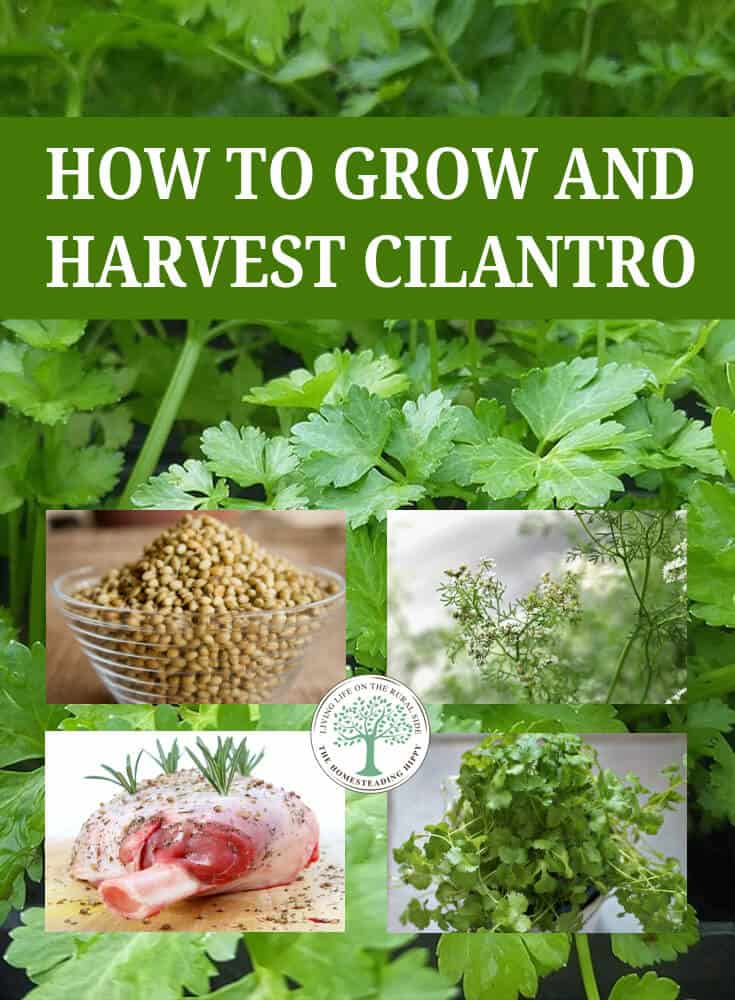Cilantro, a fast growing annual has a lifespan of between 2 months to 3 months and provides a pop of brilliant green to various dishes, and the flavor is one often associated with many Asian, Indian, Mediterranean and Mexican dishes.
Known by various names such as Chinese parsley, Mexican parsley, and coriander and among Indian people as dhania, it’s no wonder people get confused.
Cilantro (Coriandrum sativum) is both a herb and a spice. The green leaves called cilantro are used as a herb, while the seeds, known as coriander are ground up and used as a spice.

All parts of the plant are edible including the small white flowers, which can be used to garnish a salad.
To avoid disappointment here are a few tips and tricks to growing cilantro successfully.
Seed Preparation
Many people are disappointed when less than a third of the seeds planted actually germinate. The reason is that the husk surrounding the seed is often too tough for the tiny plant to break through successfully.
An Indian woman told me to put the seeds on a tray and walk on them a bit before planting, but then she plants large quantities for market gardening purposes. I did try her method and it seemed to result in better germination.

Another way is to put your seeds in a Ziploc bag and go over them with a rolling pin. You don’t want to smash the seeds inside, but break open the outer husks. Some people who have the time will pop the husks with their fingers.
An easy way is to soak the seed in lukewarm water for a day or so, leaving the container on a sunny windowsill, before planting in order to encourage the husks to soften.
Each little husk will contain 2 seeds so don’t be surprised when two tiny plants develop from each seed you planted.
Planting
Plant seed ¼ inch deep in a well-drained soil; whether it is sandy or loamy cilantro are not too fussy as long as the soil is alkaline and they get plenty of water at planting time, and in the early stages of growth. Within 6 to 10 days you will see the tiny plants pushing through the soil.
Plant close together 3 to 4 inches apart in rows about 8 inches apart. The idea with close planting is to keep the soil temperature down – if the soil temperature goes above 75 degrees Fahrenheit the cilantro tends to bolt – putting its energy into making seed for the next season.
Mulch to keep plant roots cool. This is a cool season crop that ideally needs temperatures of between 50 and 80 degrees Fahrenheit.
These are two popular varieties available that get good results:
- Santo organic cilantro is flavorful and is slow to bolt;
- Calypso is quick growing.
Although they like a sunny position if cilantro plants get some shade during the hottest part of the day it will help to keep them from flowering and setting seed. It’s not so much the air temperature but the soil temperature that affects them.
If you have just a few cilantro plants you can water with chilled water. The plants are generally around 8 to 12 inches high in a bushy formation but tend to get straggly reaching about 24 inches or more once the seed has formed.
Does cilantro keep growing if you keep cutting it?
There are claims that if you just keep cutting cilantro it will grow indefinitely. These are not true!
Cilantro has a short lifespan, so cutting the leaves will encourage bushier growth and prolong your harvest by stopping it from flowering too soon, but eventually the plant will die off.
When the plant starts flowering the leaves will change in shape becoming more feathery, as you can see in the photo below of a bee on a flowering cilantro plant. The leaves at this stage are also not as tasty.
If the plants bolt just let them set their seed and harvest it, ready to plant for the next season.
Plant new seed every two weeks so you always have fresh cilantro to add to soups, salads, guacamole, and to brighten up various dishes.
When to Plant
In cooler regions plant cilantro outdoors in spring when danger of frost is past and continue planting right through to the end of summer.
In the hotter parts of the country plant early in spring and in late autumn. If you plant in the full heat of summer the plants will tend to set seed very quickly, so be ready for this and plant at weekly intervals.
If you want to get a head start in spring in cooler areas sow the seed in paper or peat pots, egg cartons and ice cream cones – remember the ones bought for the kid’s party that have now gone a bit stale?
Some people suggest perlite and peat moss but I find a good general potting mix quite adequate to fill the containers and start the plants a couple of weeks before the last frost.
Then when the time comes for planting the tiny taproot isn’t disturbed when the cilantro seedling ‘pot’ goes into your prepared ground.
Growing Cilantro Indoors
Cilantro loves sun so make sure you have a sunny position for them. Ensure the soil is kept moist during the germination period.
Cilantro will be happy with a general potting mix and if you put in 3 to 5 seeds per 6-8 inch pot you will be able to cut cilantro leaves for kitchen use within 3 to 4 weeks of planting when the plants are around 6 inches high. Leaves can turn yellow but that may be due to lack of sunlight.

When to Harvest
It only takes 3 to 4 weeks before you can start picking your tasty leaves. Usually within 45 days though seed will have set – so that is why you need to stagger planting, and to keep cutting the leaves so the plants don’t flower but put their energy into growing more leaves.
If you don’t harvest the seed in time they will tend to self seed and you’ll have new little plants coming up all over the place.
If you one of those tidy gardeners who wants things in neat rows this can be annoying but survival type gardeners are often quite happy to plant their radishes and carrots working around the cilantro that has chosen it’s own place to grow.
Diseases
Perhaps because of the aromatic nature of the plant diseases and pests do not plague them, so you should be fine, however there are a couple of problems that could affect your plants:
- Aphids – they can be dislodged with a cold spray of water from a hose. You can then dust the plants with flour if you really need to. People use dishwashing soap and lemon juice mixed with water as a spray for aphids and whitefly but if you’re going to be picking leaves daily I wouldn’t be too keen on the idea of dish soap residue.
- Whitefly – blast off with a spray from the garden hose then for those that may remain hang up yellow pieces of card smeared with Vaseline near your plants – they like the color and will get stuck on the Vaseline and die.
- Powdery mildew – this can occur during hot dry periods when there isn’t enough air circulation and plants are overcrowded. If indoors give some water and set a fan going near them for a while.
- Leaf spot cause yellow spots on the leaves that eventually go brown. To solve this water the plants less and try to increase air circulation by either thinning plants out, or using a fan if the plants are in pots indoors.
Cilantro Tips
- I have read that you can take a cutting of cilantro, place it in water and it will make roots and can then be planted out. It’s something I have never tried so I have no idea how successful it would be. If any readers have tried this let us know.
- Cost saving. When you start out with cilantro, buying little packets of seed from a nursery can be quite expensive. I buy a big bag of whole coriander seed from a local spice shop and plant that – it’s much cheaper. After your initial planting you then have enough seeds to collect for the next crop.
- When buying cilantro in trays from a nursery, get ready to plant them out quickly, as cilantro’s lifespan is quite short, and by the time you buy them they are probably already half way through their prime time for producing leaves. Many people believe they are ‘unsuccessful’ with growing cilantro when it’s just the fact that they haven’t understood the plant’s lifespan.
How to Store and Use Cilantro / Coriander
Cilantro is a delicate herb so add fresh leaves picked straight from the garden right at the end of cooking, or use them on top of a dish, whole or chopped as a garnish otherwise you lose that crisp fresh flavor.
To store fresh leaves, harvest, wash and air dry and either store whole or chopped up in bags in the freezer.
You can harvest the green seed and keep it in the fridge to add to meals, as at this stage it is slightly more aromatic than when the husk has completely dried out.
When seeds are dry cut off the whole seed head carefully and store in a brown paper bag so the seeds can continue drying out. When completely dry store them in jars and add to food whole or grind just before using.
If you grind spices months before you use them they will lose flavor – just as you grind black peppercorns at the table rather than buying ground black pepper for a better taste.


As a child I wanted to grow up and marry a farmer… simply because it was so different from my life right on the shores of the ocean. Well, I didn’t marry a farmer but a surfer instead. The urge, however, to grow stuff and make great food for a big family never left. We are on acreage with a sea view and easy access to fresh caught crayfish and other seafood – the best of both worlds. As an artist and writer I enjoy creating new recipes, tweaking traditional ones, and sharing the results not only with family and friends, but online. Mee the rest of the team at this page.

I Now understand why all of my cilantro bolted there’s always at three and a half hour for months at the end of its life cycle and I didn’t realize that
Hi! I have cilantro that’s near life end. The seeds I planted were a red-brown color.
Some of the seeds on the plants have gone from green to pale pink.
I’m wanting to harvest the seeds, and pull up the cilantro for other plants.
If I harvest the green seeds, will they “pink” up as they dry, and be viable to plant afterwards?
If I have to, I’ll wait a few more weeks for them to ripen on the plant rather than not be able to harvest the seeds.
Thank you.